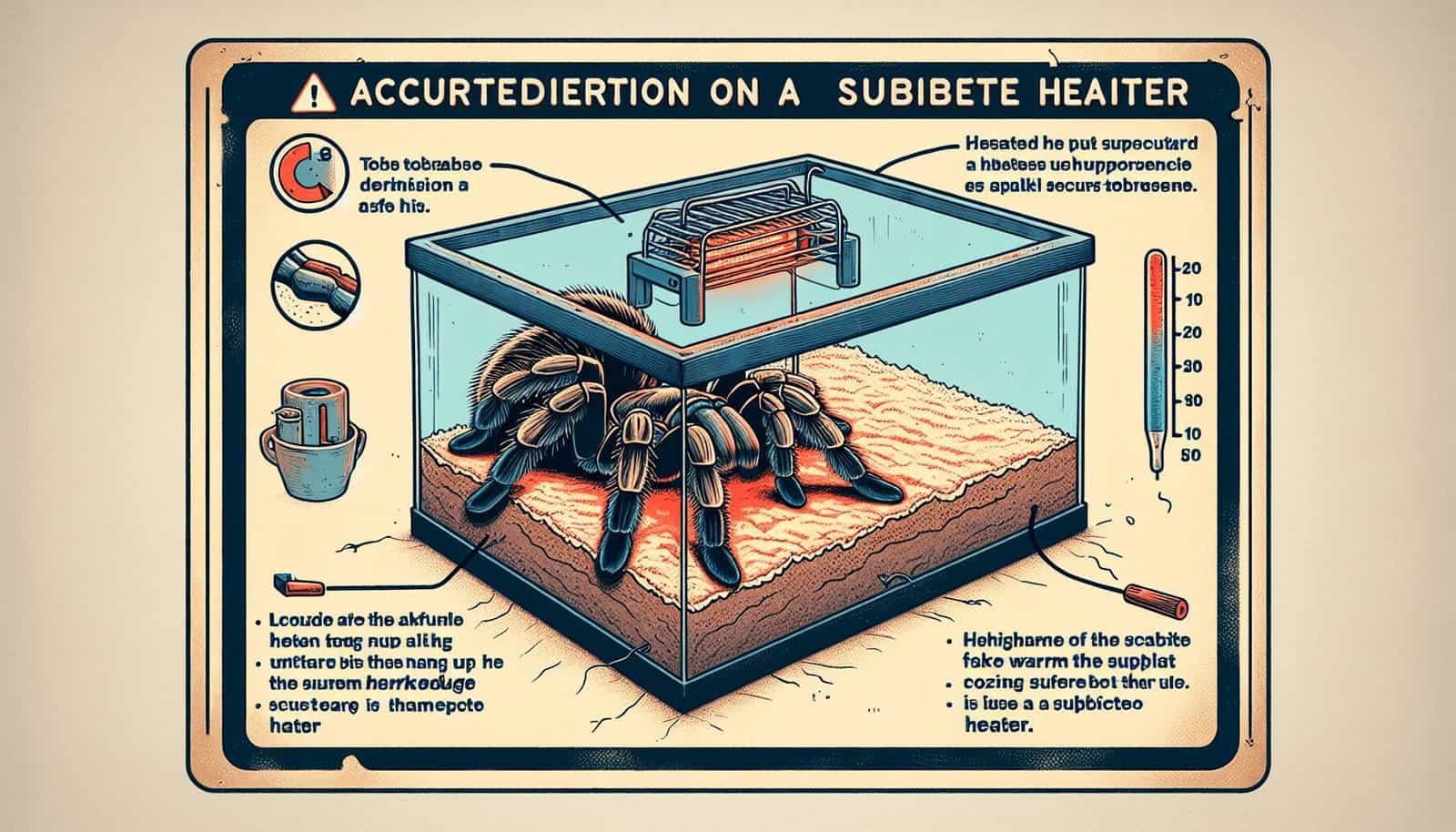Imagine being able to create the ideal living conditions for your beloved pet tarantula. Providing warmth and comfort to your eight-legged friend is essential, but have you ever wondered if enclosures with substrate heaters are suitable for tarantulas? In this article, we will explore the merits and potential risks of using substrate heaters to maintain the perfect temperature for your tarantula’s habitat. So, before you make any decisions, let’s take a closer look at whether or not tarantulas can truly thrive in enclosures with substrate heaters.

What is a substrate heater?
A substrate heater is a device used to provide heat to the substrate, or the bedding material, in a tarantula enclosure. It is designed to mimic the natural conditions that tarantulas would experience in their native habitats. By regulating the temperature of the substrate, substrate heaters help create an environment that is more conducive to the well-being and natural behavior of the tarantula.
Definition of a substrate heater
A substrate heater is typically a thin, flexible mat that is placed beneath the substrate in the tarantula enclosure. This mat is usually connected to a thermostat or temperature controller, which allows for precise regulation of the temperature. The heat generated by the substrate heater is then transferred to the substrate, creating a warm and comfortable environment for the tarantula.
Purpose of a substrate heater
The main purpose of a substrate heater is to create and maintain the optimal temperature range for tarantulas in captivity. Temperature plays a crucial role in the health and well-being of tarantulas, as it affects their metabolism, digestion, and overall activity levels. By providing a consistent and controlled heat source, substrate heaters help ensure that tarantulas can thrive in their enclosures.
Tarantula habitat requirements
Tarantulas have specific habitat requirements that need to be met in order for them to live healthy and happy lives in captivity. By understanding these requirements, tarantula owners can provide an environment that closely mimics their natural habitats.
Optimal temperature range
Tarantulas thrive in temperatures that range between 75 to 85 degrees Fahrenheit (24 to 29 degrees Celsius). This temperature range is different for each species, so it’s important to research the specific requirements of the tarantula you own. Maintaining the correct temperature is essential for the tarantula’s metabolic processes, as it allows for proper digestion, molting, and overall activity.
Importance of humidity
Humidity is another crucial factor in creating a suitable tarantula habitat. While the specific humidity requirements vary among tarantula species, most prefer a humidity level between 60% to 80%. Humidity helps with the tarantula’s respiratory function and also aids in the molting process. It is vital to monitor and maintain the humidity levels within the enclosure to prevent excessive dryness or dampness, which can lead to health issues for the tarantula.
Substrate preferences
Tarantulas often have specific preferences for the type of substrate they prefer in their enclosure. Some common substrate options include peat moss, coconut fiber, vermiculite, and a combination of these materials. The choice of substrate depends on factors such as the tarantula species, burrowing behavior, and moisture retention. It is important to provide a substrate that allows for natural burrowing behavior and retains moisture, as this helps create a comfortable and suitable habitat for the tarantula.
Burrowing behavior
Many tarantulas are burrowers, meaning they like to dig and create tunnels in their enclosure. This behavior is important for their well-being and provides them with a sense of security. When setting up the tarantula’s enclosure, it is essential to provide enough substrate depth for them to burrow comfortably. Substrate heaters can be beneficial in maintaining the ideal temperature within these burrows, allowing the tarantula to engage in its natural behavior while still providing warmth.

Advantages of using substrate heaters
Using substrate heaters in tarantula enclosures offers several advantages that contribute to the overall well-being and health of these fascinating creatures.
Maintaining ideal temperature
One of the main advantages of using substrate heaters is their ability to maintain a constant and optimal temperature for the tarantula. With a substrate heater, you can ensure that the tarantula’s environment remains within the recommended temperature range consistently. This helps with the tarantula’s overall health and allows them to carry out essential physiological processes, such as digestion and molting, more efficiently.
Promoting natural behavior
Tarantulas have specific behavioral patterns, and maintaining a suitable temperature through substrate heaters can help promote and encourage these natural behaviors. The warmth provided by the substrate heater mimics the conditions found in their natural habitats, allowing the tarantulas to engage in activities such as burrowing, hunting, and exploring. By creating an environment that supports their natural behaviors, tarantulas are more likely to thrive and exhibit their natural instincts.
Improving digestion and metabolism
Proper temperature regulation is crucial for the tarantula’s digestion and metabolism. By using a substrate heater, you can ensure that the substrate remains warm, which aids in the digestion and metabolism of the tarantula. The warmth provided by the substrate heater helps facilitate the breakdown of food and allows for more efficient nutrient absorption. In turn, this promotes better growth and overall health in the tarantula.
Considerations for using substrate heaters with tarantulas
While substrate heaters can be beneficial for tarantula enclosures, it is important to take certain considerations into account to ensure the safety and well-being of your tarantula.
Choosing the right type of substrate heater
When selecting a substrate heater, it is important to choose one that is suitable for tarantula enclosures. There are various options available, such as heat mats and heat cables, which can be placed beneath the substrate. It is crucial to select a substrate heater that is reliable, durable, and designed specifically for use with tarantulas. Researching and investing in a high-quality product will ensure the safety and effectiveness of the substrate heater.
Avoiding excessive heat
While maintaining the ideal temperature is important, it is equally crucial to avoid excessive heat in the tarantula enclosure. Temperatures that are too high can be harmful to the tarantula and may even lead to overheating, dehydration, or stress. It is essential to closely monitor the temperature and adjust the thermostat accordingly to prevent any extremes. Providing a thermal gradient within the enclosure allows the tarantula to choose the temperature it prefers, ensuring it has control over its own comfort.
Monitoring temperature and humidity levels
Regular monitoring of temperature and humidity is essential when using substrate heaters. It is recommended to use a separate thermometer and hygrometer to accurately measure these parameters within the enclosure. By keeping a close eye on the temperature and humidity levels, you can make necessary adjustments to ensure they remain within the tarantula’s ideal ranges. Monitoring should be done consistently to account for any changes in weather conditions or other environmental factors.
Preventing accidental burns
One potential risk when using substrate heaters is the potential for accidental burns to the tarantula. To avoid this, it is important to ensure that the tarantula cannot come into direct contact with the substrate heater. Placing a layer of insulation, such as a heat-resistant material or a thick layer of substrate, between the tarantula and the substrate heater can help prevent accidental burns. Additionally, providing hides or other structures for the tarantula to seek refuge in can further minimize the risk of accidental burns.

Potential risks of using substrate heaters with tarantulas
While substrate heaters offer numerous benefits, there are potential risks associated with their use. Being aware of these risks allows tarantula owners to take necessary precautions to mitigate them.
Drying out the enclosure
One of the risks associated with substrate heaters is the potential to dry out the enclosure if not properly managed. The constant heat provided by the substrate heater can cause increased evaporation, which can lead to decreased humidity levels within the enclosure. This can be harmful to tarantulas that require higher humidity levels. Regularly monitoring humidity levels and adjusting the enclosure’s ventilation or misting routine can help maintain the necessary humidity for the tarantula’s well-being.
Risk of overheating
Inadequate monitoring of temperature levels can lead to overheating in the tarantula enclosure. This can be dangerous and even fatal for the tarantula. It is crucial to use reliable thermometers and thermostats to ensure that the temperature remains within the recommended range. It is also important to double-check the functionality and accuracy of these devices regularly to prevent any malfunctions that could lead to overheating.
Inadequate temperature regulation
Another potential risk of using substrate heaters is inadequate temperature regulation. If the thermostat or temperature controller is not functioning properly, it may result in too high or too low temperatures within the enclosure. Tarantulas are sensitive to temperature fluctuations, and extreme conditions can negatively impact their health. Regularly checking the functionality of the temperature regulation devices and ensuring their accuracy is paramount for maintaining suitable temperatures within the enclosure.
Reduced natural thermoregulation abilities
While substrate heaters can provide consistent and regulated heat, there is a concern that tarantulas may become reliant on the artificial heat source and may lose their natural ability to thermoregulate. This can potentially lead to dependence on the substrate heater and an inability to tolerate temperature variations. To mitigate this, it is important to provide a thermal gradient within the enclosure, allowing the tarantula to choose the temperature it prefers and exercise its natural thermoregulation abilities.
Alternative heating methods for tarantulas
While substrate heaters are a popular choice for providing heat to tarantula enclosures, there are alternative heating methods available that can also be effective in creating suitable environments for these arachnids.
Heat mats
Heat mats, also known as under-tank heaters, are commonly used for reptile enclosures but can also be suitable for tarantulas. These mats are placed beneath the enclosure, providing heat that warms both the substrate and the air. Heat mats can be an alternative to substrate heaters, especially for enclosures with lower humidity requirements.
Ceramic heat emitters
Ceramic heat emitters are another heating option for tarantula enclosures. These emitters produce radiant heat, which warms the air within the enclosure. Unlike heat mats, ceramic heat emitters do not warm the substrate directly. They are commonly used for larger enclosures and can be beneficial when creating thermal gradients within the enclosure.
Radiant heat panels
Radiant heat panels are similar to ceramic heat emitters but provide a larger surface area of heat distribution. These panels emit infrared heat, which warms the air and surfaces within the enclosure. Radiant heat panels can be suitable for larger enclosures and can create a more even distribution of heat compared to other heating methods.
Room temperature and natural sunlight
For some tarantula species, room temperature and natural sunlight may be sufficient to maintain their ideal temperature range. Room temperature within the recommended range eliminates the need for additional heating devices. Natural sunlight can also provide warmth, as long as the enclosure is placed in a location where it receives consistent and indirect sunlight. These methods can be considered for tarantulas that can tolerate variations in temperature and have lower heat requirements.

Professional opinions and experiences
Tarantula experts and enthusiasts have valuable insights and experiences when it comes to using heating methods in tarantula enclosures. Learning from their expertise can provide further guidance for tarantula owners.
Tarantula experts’ recommendations
Many experts in the field of tarantula care recommend using substrate heaters or alternative heating methods to provide a suitable environment for tarantulas. They stress the importance of maintaining the correct temperature range and humidity levels for each tarantula species. Experts often advocate for a combination of heating methods, such as substrate heaters and ceramic heat emitters, to create thermal gradients and allow the tarantula to choose its preferred temperature.
Case studies and anecdotal evidence
Several case studies and anecdotal evidence from experienced tarantula keepers support the use of heating methods in tarantula enclosures. These accounts often highlight the positive effects of proper temperature regulation on tarantula behavior, health, and overall well-being. These real-world experiences provide practical insights into the benefits of substrate heaters and alternative heating methods.
Balancing heating methods with tarantula health
While tarantula keepers generally agree on the benefits of using heating methods in tarantula enclosures, they also emphasize the importance of considering the individual needs and preferences of each tarantula. Tarantula health should always be the top priority, and heating methods should be adjusted and balanced accordingly. Regular observation, monitoring, and adjustment of heating methods based on a tarantula’s response are essential to ensuring its well-being.
Common misconceptions about substrate heaters and tarantulas
There are several common misconceptions surrounding the use of substrate heaters and tarantula care in general. By addressing these misconceptions, it is possible to provide accurate information and dispel any misunderstandings.
Misunderstanding tarantula heat requirements
One common misconception is that tarantulas require high temperatures similar to those found in tropical rainforests year-round. While certain tropical tarantulas may have higher heat requirements, many species originate from regions with temperature variations. It is important to research and understand the specific heat requirements of the tarantula species kept in captivity to provide an environment that matches their natural habitat.
Assumptions about naturalistic temperature gradients
Some tarantula owners assume that a single temperature throughout the enclosure is sufficient for the tarantula’s well-being. Naturalistic temperature gradients are often overlooked, which can limit the tarantula’s ability to express its natural behaviors and find its preferred comfort zone. Providing a thermal gradient allows the tarantula to regulate its body temperature and choose a suitable microclimate within the enclosure.
Myths about tarantula metabolism and digestion
There are myths surrounding tarantula metabolism and digestion, which can lead to incorrect heating practices. One common myth is that higher temperatures speed up metabolism and digestion in tarantulas. While warmth does aid in digestion, excessively high temperatures can be detrimental to the tarantula’s health. It is crucial to maintain the recommended temperature range and not rely solely on high temperatures to enhance metabolic processes.

Best practices for keeping tarantulas in enclosures with substrate heaters
To create a suitable and safe environment for tarantulas with substrate heaters, it is important to follow some best practices.
Researching tarantula species-specific requirements
Each tarantula species has its own set of requirements, including temperature preferences, humidity levels, and substrate preferences. Researching and understanding these specific requirements is vital when setting up an enclosure with a substrate heater. By tailoring the environment to the individual tarantula’s needs, you can ensure its well-being and promote natural behaviors.
Providing thermal gradients
Creating thermal gradients within the enclosure is essential for the tarantula’s ability to regulate its body temperature. By providing a range of temperatures, the tarantula can move to areas that suit its comfort level. This allows the tarantula to engage in natural behaviors such as basking or seeking cooler areas, enhancing its overall well-being.
Using thermostats and temperature controllers
To ensure precise and accurate temperature regulation, it is recommended to use thermostats or temperature controllers in conjunction with substrate heaters. These devices allow for better control and monitoring of the heat output, preventing any temperature extremes that could harm the tarantula. Regularly checking and calibrating these devices will help maintain a stable and suitable temperature range.
Regularly monitoring temperature and humidity
Consistent monitoring of temperature and humidity levels is crucial to ensure the well-being of the tarantula. Using separate thermometers and hygrometers for accurate measurements is recommended. Regularly checking these parameters throughout the day and making adjustments as needed will help maintain an optimal environment for the tarantula.
Conclusion
The question of whether tarantulas can be kept in enclosures with substrate heaters has been thoroughly explored. While substrate heaters can provide numerous benefits for tarantulas, it is important to consider the specific requirements of each individual tarantula species and monitor the temperature and humidity levels consistently.
By using substrate heaters or alternative heating methods, tarantula owners can create environments that closely mimic their natural habitats and promote their overall health and well-being. Balancing heating methods with naturalistic behaviors and individual tarantula needs is essential for providing them with the best possible living conditions.
In conclusion, substrate heaters can be a valuable tool in tarantula husbandry when used responsibly and in conjunction with proper research, monitoring, and consideration of the tarantula’s specific requirements. By making informed decisions based on research and professional advice, tarantula owners can create an environment in which their beloved arachnids can thrive and exhibit their natural behaviors.